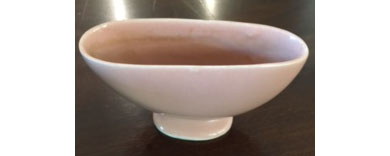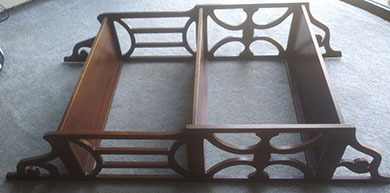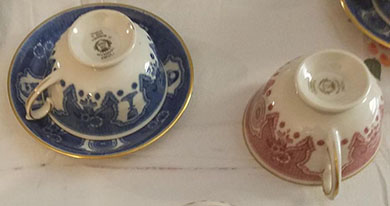 |
|
|||
 |
 |
|||
RINKER ON COLLECTIBLES — Column #1813 Copyright © Harry Rinker, LLC 2021 Questions
and Answers
QUESTION: I inherited a deep oval, pinkish glazed bowl, possibly a centerpiece bowl, from my parents. They lived in Santa Monica, California, when they acquired it. The inscribed mark on the bottom reads: “WINDFIELD / 418 / PASADENA.” There is a penciled “9” to the right of the “418.” I have no idea what this means. What history and value can you provide for my bowl? – CF, Clovis, CA, Email Question 
ANSWER: Winfield Pottery, also listed as the Winfield Pottery/China Company, was founded in 1929. Originally located in Pasadena, California, Winfield Pottery moved to Santa Monica in 1946. Winfield’s primary product line was dinnerware, the most frequently encountered Winfield product when researching the company on the internet. In addition to dinnerware, Winfield made tabletop decorative accessories, such as bowls and ashtrays. Most were glazed with a single color or two colors – one on the outside and the second on the inside. These pieces were similar in design to tabletop decorative accessories made by rival west coast potters such as Bauer. Your pinkish color sings early 1950s, when charcoal and pink were popular household and fashion colors. “418” is the mold number used to create the bowl. The “9” most likely represents a secondary market sale price. Nine dollars is far too high a price for this piece in the 1950s. In 1946, the American Ceramic Company, also located in Santa Monica, bought the rights to manufacture some of the Winfield patterns. Hence, American Ceramic Company’s “Gabriel” trademarked pieces are identical to the patterns on Winfield dinnerware. Winfield Pottery ceased operations in 1962, one of the many victims of cheap foreign imports and the rising popularity of plastic dinnerware. My internet research revealed limited information about non-dinnerware Winfield pieces. I found a few references to Winfield’s Duotone [two colors – one inside, one outside] line. I also found Winfield dinnerware pieces that had the same pink glaze found on your bowl. Using these prices for comparison purposes, a fair secondary market value for your bowl west of the Rockies is $12.00 to $15.00 and east of the Rockies $8.00 to $10.00. QUESTION: I recently came across a cockatoo wall pocket signed by Delphin Massier, a French potter. I spent hours trying to find an identical example online. I could not find one anywhere. I did see a rooster head wall pocket signed by Massier. What would be a reasonable value for a cockatoo wall pocket? – SV, Email Question ANSWER: Delphin Massier (1836-1907) was a member of the Massier family, a dynasty of ceramists established by Pierre Massier (1707-1748) in Vallauris, France. Pierre Massier was succeeded by Jacques Massier (1806-1871) who was responsible for giving the Massier workshop a new lease on life by expanding its production from simple utilitarian ceramics to innovative and artistic art ceramics. Italian potter Gondolfi Gaetano arrived in 1859. He trained Delphin and his brother Clément (1844-1917). When Jacques died in 1871, Delphin and Clément inherited the firm. Their cousin Jerome (1830-1915) joined the firm. Eventually, the brothers separated and moved to different locations within Vallauris. Jerome’s son Jean Baptiste Massier gained control of the initial workshop site. He produced polychrome enameled faience destined for use in the garden or home. Massier family production peaked at the turn of the 20th century. Massier issued elaborate sales catalogs picturing its merchandise. The catalogs allow the identification of Massier molds as well as showcasing the diversity of its products. Massier produced pieces that were representative of popular period design styles. At the end of the 19th century, Delphin and Jerome devoted their design efforts to Art Nouveau. The cockatoo was a popular Art Nouveau motif. Freeman’s, a Philadelphia auction firm, offered a Delphin Massier majolica swallow wall pocket at its January 28, 2020 auction. It had a presale estimate of $300.00 t0 $500.00 and sold for $552.50. WorthPoint.com’s Worthopedia has a listing for an identical example that brought $229.50 on eBay on October 25, 2020. Worthopedia also contained a listing for a Delphin Massier cockatoo head wall pocket that realized $519.00 on eBay on December 3, 2007. Because molds were created, this is most likely the piece you came across. Given the above, your cockatoo head wall pocket has a secondary market value between $500.00 and $560.00. Secondary market demand for Delphin Maisser three-dimensional animal figures and many vases is much higher. FINAL NOTE: 1st Dibs, a notoriously overpriced direct sale website, is offering more than 45 Delphin Massier pieces for sale. To obtain a realistic secondary market value for these pieces cut the asking price by one-half to two-thirds. QUESTION: I acquired a Paine Furniture Company wall shelf. It consists of three shelves. The second and third shelves are separated by Colonial-style, lattice work sides. The back of the bottom shelf is marked “43.7083.” Other than needing a good cleaning and having some scratches, it is in excellent condition. I am trying to determine its worth. – PS, Hampden, ME, Email Question 
ANSWER: The Paine Furniture Company was a large furniture company/store located in Boston. The first floor of its building, with entrances on Arlington, Stuart, and St. James, contained the lobby and retail sales gallery. The upper floors featured showrooms for accessories, bedding, draperies, furniture, and rugs in addition to manufacturing, repair, and upholstery areas. In addition to producing its own brand name furniture, Paine Furniture also sold furniture made by other manufacturers. No one is going to collect 50 wall shelves, albeit I know individuals who own a dozen or more. The latter use them to display their smalls. The value of your wall shelf is a combination of decorative value (a welcome accessory for a Colonial Revival room setting) and reuse (functional no matter in what decorative setting it is used.). The fact that it was made by or sold by Paine adds no additional value. If it needs a good cleaning and has scratches, it is not in excellent condition. Even after you clean it and fix the scratches (use a furniture renew kit available at Big Box and smaller hardware stores), its condition is closer to very good. The best way to describe the finished shelf is “room ready,” meaning it is ready to hang on the wall without anything further needing to be done to it. As it stands, the value of you wall shelf is around $25.00. After you have cleaned it up and fixed the scratches, its value increases to $40.00. QUESTION: I own two sets, one with blue and the other with red decals, of four Moravian historical cups and saucers. The decals contain images of John Hus, David Nitschmann, a chalice, and the great seal of the Moravian Church. The back is marked “Lamberton Scammell.” I am moving and no longer appreciate them. What is your advice? – BN, Email Question 
ANSWER: These cups and saucers along with a series of a dozen plates were designed to appeal to members of the Moravian faith and sold primarily in the vicinity of Bethlehem, Pennsylvania, and Winston-Salem, North Carolina. When the initial production was exhausted, the Moravian Bookstore in Bethlehem worked with Lamberton to reissue the series. WorthPoint.com’s Worthopedia has more than 15 listings for Moravian historical cup and saucer pairs. There appears to be no price difference between the two colors. A cup and saucer pair has a sell through value on eBay between $15.00 and $20.00. Replacements, Ltd. has one red cup and saucer pair in stock with a list price of $19.99, reduced from$29.99. It has seven different red center decal Moravian dinner plates from the series with an asking price between $33.99 or $29.99 depending on the center view. Your Moravian cups and saucers have minimal to no value to someone who is not a member of the Moravian faith. Those that own them tend to display or store them rather than use them, thus diminishing any interest by younger Moravians. Unless you live in the vicinity of Bethlehem or Winston-Salem, chances of selling a paired cup and saucer set for over $4.00 is slim. In the former areas, an expectation of $8.00 to $10.00 a set is possible. These numbers are less than current sell through prices on eBay. After you deduct eBay’s fees and add in the value of your time involved in the selling and shipping process, even at $15.00 you are giving the cups and saucers away for free. My recommendation is to donate them to the Moravian Archives in Bethlehem, ask them to sell them in their gift shop, and credit the proceeds to the Archives as a donation from you.
|
||||